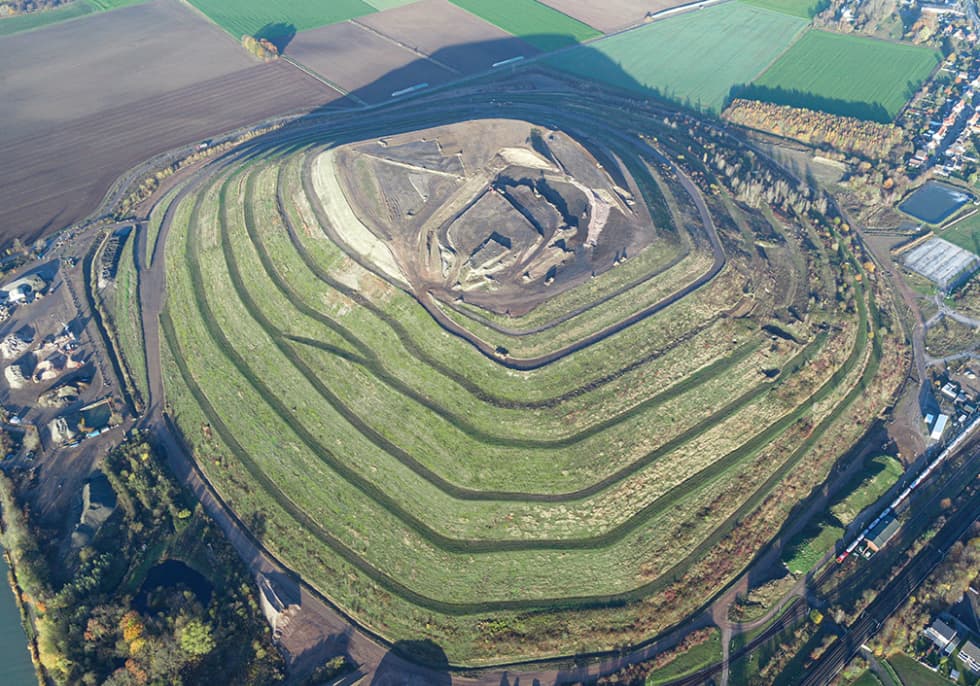GREENING OF TAILINGS
THE ADVANTAGES
The stockpiling is the world’s most common practice for the extraction of potash salts. In order to compensate the impact on the environment, we are actively involved in the area of recultivation of potash tailings piles. To reduce the development of saline water we have developed, applied for and implemented different processes. By recovery of waste residues in the covering layers we preserve natural resources and landfill capacities – and at the same time create an ecologically high-quality project to promote biodiversity.
Ecologically viable solution
The covering of these tailings piles makes an important contribution in reducing the environmental impacts and consequently sustainable raw material extraction.
- Reduction of saline water
The covering layers can save rainwater and release this back into the atmosphere. In a greening, this effect is strengthened by the evapotranspiration of plants. - Conserving natural resources
By recovery of waste residues within the covering layers, the use of natural resources is largely dispensed with. - Saving landfill capacities
By recovery of e.g. soil and building rubble for covering, valuable landfill capacities are preserved. - Increasing biodiversity
The revegetated covering layers offer new habitat for various plants and animals, therefore contributing to diversity of species. - CO2 saving
By avoiding the extraction of natural resources and the inclusion of carbon dioxide in the natural soil formation on the cover layer, we are making a contribution to reducing greenhouse gas.
“By recovery of waste residues the greening of tailings piles is making a valuable contribution to sustainable potash production.”
Dr. Arne Schmeisky, Contributor Project Development Greening of Tailings
Interesting to know
The greening of tailings piles makes an enormous contribution to biodiversity. In Friehrichshalle (Sehnde) 192 various plant species could be verified on the covered tailings.
Greening saves water: An established greening can evaporate on a long-term average at least 80% precipitation. However, the efficiency of the covering can even be higher.

Greening will significantly reduce the portion of mine wastewater caused by rainfall. At the same time, a new habitat for plants and animals is created during the covering method with greening, which contributes to local biodiversity. The recovery of waste residues conserves natural resources, but also valuable landfill capacities.
Impressive projects
K+S has already been covering tailings piles for several decades. An enormous research effort has been carried out to continue developing existing procedures and to establish new solutions. Various small waste dumps have already been covered successfully; however, the challenges are medium-sized and large waste tips (tailings piles). We are working intensively on this.


Future references
The medium-sized tailings pile of Friedrichshall in Sehnde will be covered finally in 2021. The follow-up project, Lower Saxony tailings pile, is currently in its application process. The covering of tailings piles of this size is state of the art and will also be carried out at the tailings piles in Südharz and in Lower Saxony. K+S has developed new methods in cooperation with various institutions, in order to be able to cover and renature large tailings piles such as e.g. at the Werra in future.

Current projects
Currently the Friedrichshall tailings pile at the Sehnde site is covered with a soil/building rubble method. The cover works are set to be completed in 2021. The experiences gained here are the foundation for the next covering projects. What’s more, the tailings pile at K+S Sigmundshall site is covered with the thin layer process developed there.

Further projects scheduled
Currently the approval procedure for covering the Lower Saxony tailings pile in Wathlingen is ongoing. This will be covered with a thin layer method. We use the experiences from Friedrichshall to continue to develop the cover system, so that one of the most modern and efficient cover system in the world can be implemented here.

